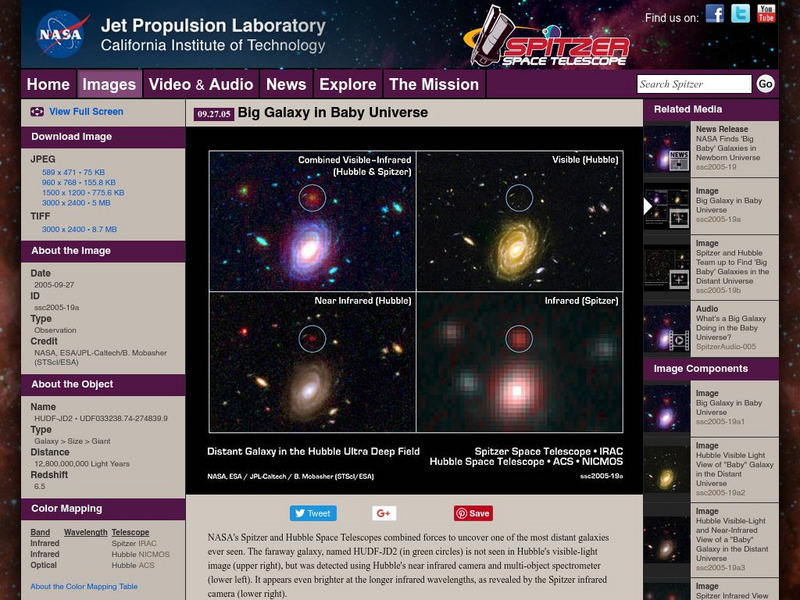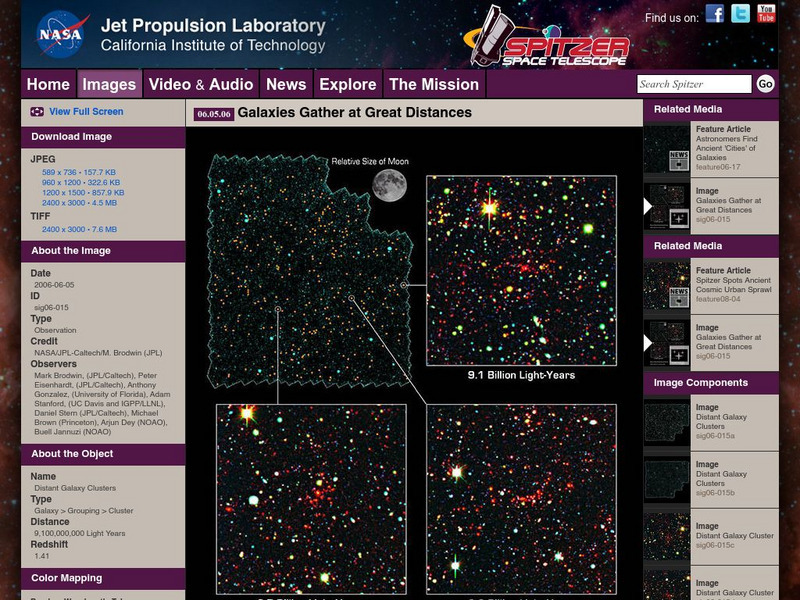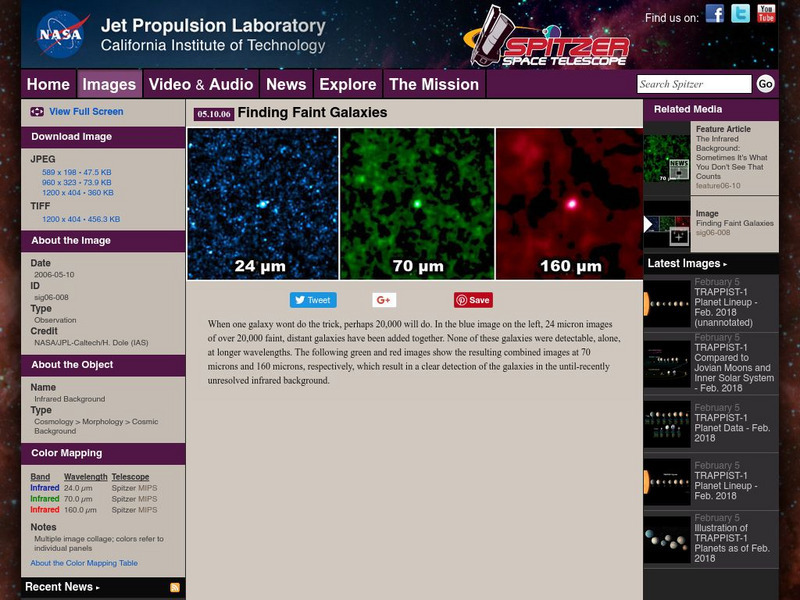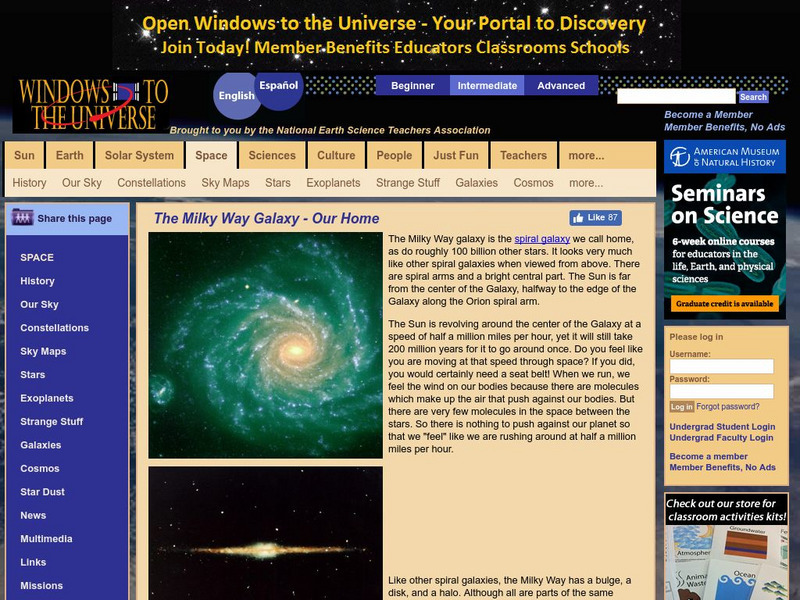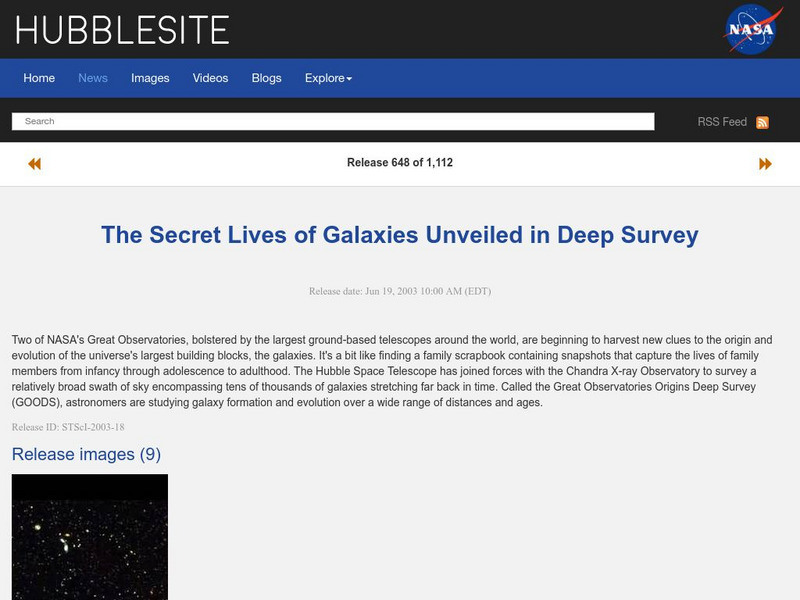Hi, what do you want to do?
TED Talks
Ted: Ted Ed: Could Human Civilization Spread Across the Whole Galaxy?
Could human civilization eventually spread across the whole Milky Way galaxy? Could we move beyond our small, blue planet to establish colonies in the multitude of star systems out there? These questions are pretty daunting, but their...
California Institute of Technology
Cool Cosmos: Ask an Astronomer
Cool Cosmos and NASA help explore the world of galaxies! This site provides the answers to kid's most frequently asked questions.
Other
Sky Server: Galaxies
SkyServer explains and presents images of spiral galaxies, elliptical galaxies, irregular galaxies, galaxy clusters, galaxy collisions and the like.
California Institute of Technology
Spitzer Space Telescope: Dissection of a Galaxy
The Dissection of a Galaxy image offered here examines how a galaxy functions by taking it apart through an image. In addition, a detailed textual overview explains various specifics of the picture.
California Institute of Technology
Spitzer Space Telescope: Our Galaxy's 'Twin'
This image, titled "Morphology of Our Galaxy's 'Twin'" features three individual pictures of a nearby spiral galaxy that closely resembles our own. The text under the image details various specifics about the picture.
California Institute of Technology
Spitzer Space Telescope: Big Galaxy in Baby Universe
This image, titled "Big Galaxy in Baby Universe" features an infrared picture in four parts of a distant galaxy. The text under the image details various specifics about the picture.
California Institute of Technology
Spitzer Space Telescope: Galaxies Gather
Under the heading, "Galaxies Gather at Great Distances" this site examines (and discusses) an image featuring a group and cluster of galaxies. The text goes on to describe details specific to the image.
California Institute of Technology
Spitzer Space Telescope: Finding Faint Galaxies
The brief text that accompanies the image at this site (titled Finding Faint Galaxies) describes details of the picture which features faint images of galaxies enhanced by infrared.
Mocomi & Anibrain Digital Technologies
Mocomi: What Is a Galaxy?
Explains what galaxies are and their different shapes. Includes details on the Milky Way.
California Institute of Technology
Nasa: Great Observatories Present Rainbow of a Galaxy
The Great Observatories Present Rainbow of a Galaxy image is part of a series of photographs taken from the Spitzer Space Telescope. The picture is accompanied by a brief textual overview outlining specific details in the picture.
Ducksters
Ducksters: Astronomy for Kids: Galaxies
Kid's learn about the science of Galaxies. Large groups of stars such as the Milky Way throughout the universe are an interesting part of astronomy.
Other
University of Leicester: Elliptical Galaxies
Provides a general overview of elliptical galaxies, including a look at what defines an elliptical galaxy, what determines its shape, and it's physical nature.
National Earth Science Teachers Association
Windows to the Universe the Milky Way Galaxy
Learn what Milky Way galaxy is made of and what it looks like, as well as how it relates to other known galaxies. Read "Questions and answers about the Milky Way" for further information.
American Museum of Natural History
American Museum of Natural History: Ology: Milky Way Galaxy
How big is a billion? Find out some interesting facts about our galaxy, the Milky Way, and its billion stars.
University of Texas at Austin
The University of Texas Mc Donald Observatory: Stars and Galaxies
Do galaxies collide? Apply concepts of scale to grasp the distances between stars and galaxies.
American Association of Physics Teachers
Com Padre Digital Library: Open Source Physics: Colliding Galaxies
Examine colliding galaxies with this science simulation that demonstrates how galactic bridges are formed and how galactic cores are made up.
NASA
Nasa: Dwarf Galaxies
This space telescope image, "Dwarf Galaxies Swimming in Tidal Tails" features little galaxies forming in the midst of two colliding galaxies. In addition, a detailed textual overview explains various specifics of the picture.
NASA
Nasa: Antennae Galaxies
This image, titled "Fire Within the Antennae Galaxies" features three individual pictures of the antennae galaxies taken with different equipment (x-ray, infrared, etc). The text under the image details various specifics about the picture.
NASA
Nasa: Spiral Galaxy
This Spiral Galaxy image is part of a series of photographs taken from the Spitzer Space Telescope. The picture is accompanied by a textual overview of a spiral galaxy with specific attention given to the details of the picture.
Space Telescope Science Institute
Hubble Site: Secret Lives of Galaxies
This site is provided by HubbleSite from NASA. "Telescopes around the world are beginning to harvest new clues to the origin and evolution of the universe's largest building blocks, the galaxies." Site offers links to images, video,...
University of Cambridge
University of Cambridge: Cosmology: Galaxies
This site from the Cambridge Relativity provides a brief description of the structure of the Milky Way galaxy. The parts described are the disc, bulge, and halo.
Cosmos 4 kids
Cosmos4 Kids: Galaxies
Learn the basic facts about galaxies. Brief, to the point text make this site most appropriate for younger students.
Science Buddies
Science Buddies: The Milky Way and Beyond: Globular Clusters
Globular clusters, compact groups of about a million stars that move around together in galaxies, are among the oldest objects found in the universe. Since they are found most galaxies and since they've been around for so long, globular...
PBS
Pbs: Nova Online: Galaxies, Clusters, and Superclusters
PBS site explores these building blocks of the universe as well as their various types and clusters.
Other popular searches
- Galaxies 5 E's
- Stars and Galaxies
- Types of Galaxies
- Milky Way Galaxies
- Universe Stars Galaxies
- Universe and Galaxies
- Classifying Galaxies
- Galaxy Galaxies
- Active Galaxies
- Galaxies and Space
- Solar System Galaxies
- Spiral Galaxies










